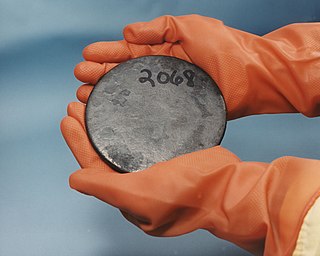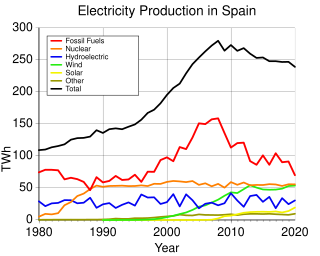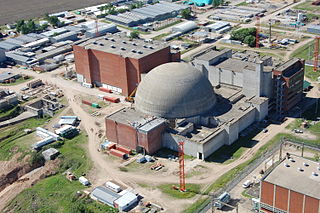External links
- Report of the National Atomic Energy Commission of Argentina (CNEA), November 2004, (PDF, 2353KB)
- El Reactor RA - 1, CNEA web page (in Spanish)
- El Reactor RA - 1 - Características, CNEA web page (in Spanish)
RA-1 Enrico Fermi is a research reactor in Argentina. It was the first nuclear reactor to be built in that country and the first research reactor in the southern hemisphere.
Construction started in April 1957, with first criticality on 20 January 1958. By contrast, the HIFAR reactor in Australia went critical just six days later, on 26 January 1958. The RA-1 reactor produced the first medical and industrial radioisotopes made in Argentina, and was used to train staff for the first two nuclear power stations there.
It is a pool type, with enriched uranium oxide fuel (20% U-235), light water coolant and moderator, and a graphite reflector. It produces 40 kilowatts of thermal energy at full authorized power.
It has been modernized on several occasions, and is currently used for research and teaching.

Uranium-235 is an isotope of uranium making up about 0.72% of natural uranium. Unlike the predominant isotope uranium-238, it is fissile, i.e., it can sustain a nuclear chain reaction. It is the only fissile isotope that exists in nature as a primordial nuclide.
Atomic Energy of Canada Limited (AECL) is a Canadian Crown corporation and the largest nuclear science and technology laboratory in Canada. AECL developed the CANDU reactor technology starting in the 1950s, and in October 2011 licensed this technology to Candu Energy.
In nuclear physics, an energy amplifier is a novel type of nuclear power reactor, a subcritical reactor, in which an energetic particle beam is used to stimulate a reaction, which in turn releases enough energy to power the particle accelerator and leave an energy profit for power generation. The concept has more recently been referred to as an accelerator-driven system (ADS) or accelerator-driven sub-critical reactor.
A criticality accident is an accidental uncontrolled nuclear fission chain reaction. It is sometimes referred to as a critical excursion, critical power excursion, divergent chain reaction, or simply critical. Any such event involves the unintended accumulation or arrangement of a critical mass of fissile material, for example enriched uranium or plutonium. Criticality accidents can release potentially fatal radiation doses if they occur in an unprotected environment.
DIDO was a materials testing nuclear reactor at the Atomic Energy Research Establishment at Harwell, Oxfordshire in the United Kingdom. It used enriched uranium metal fuel, and heavy water as both neutron moderator and primary coolant. There was also a graphite neutron reflector surrounding the core. In the design phase, DIDO was known as AE334 after its engineering design number.

The Petten High Flux Reactor (HFR) is a nuclear research reactor located in Petten, Netherlands. The HFR is on the premises of the Petten research centre and it is a high flux reactor. It is owned by the Joint Research Centre (JRC) and managed by the Nuclear Research and Consultancy Group (NRG). The HFR’s original purpose was to provide experience and irradiation capabilities for the nascent Dutch nuclear power program. Construction began in 1958, and the reactor reached criticality on the 9th of November, 1961.

Research reactors are nuclear fission-based nuclear reactors that serve primarily as a neutron source. They are also called non-power reactors, in contrast to power reactors that are used for electricity production, heat generation, or maritime propulsion.

The National Atomic Energy Commission is the Argentine government agency in charge of nuclear energy research and development.
The Dhruva reactor is India's largest nuclear research reactor. It was the first nuclear reactor in Asia proper. Located in the Mumbai suburb of Trombay at the Bhabha Atomic Research Centre (BARC), it is India's primary generator of weapons-grade plutonium-bearing spent fuel for its nuclear weapons program. Originally named the R-5, this open pool reactor first went critical on 8 August 1985 after 10 years of construction. However, the unit did not attain full power until 1988. The reactor experienced at least one serious accident when 4 metric tons of heavy water overflowed from the reactor core in 1985 following vibration problems.

The Embalse Nuclear Power Station is one of three operational nuclear power plants in Argentina. It is located on the southern shore of a reservoir on the Río Tercero, near the city of Embalse, Córdoba, 110 km south-southwest of Córdoba City.

INVAP S.E. is an Argentine company that provides design, integration, construction and delivery of equipment, plants and devices. The company operates in North America, Europe, Asia Pacific, Latin America, the Middle East and Africa, and delivers projects for nuclear, aerospace, chemical, medical, petroleum and governmental sectors.
The 2006 Argentine nuclear reactivation plan is a project to renew and reactivate the development of nuclear power in Argentina. The main points of the plan were announced by the Argentine government through Planning Minister Julio de Vido during a press conference on 23 August 2006. They include:

Spain has five active nuclear power plants with seven reactors producing 20% of the country's electricity as of 2023.
Nuclear power is the fifth-largest source of electricity in India after coal, gas, hydroelectricity and wind power. As of November 2020, India has 23 nuclear reactors in operation in 8 nuclear power plants, with a total installed capacity of 7,380 MW. Nuclear power produced a total of 43 TWh in 2020–21, contributing 3.11% of total power generation in India. 10 more reactors are under construction with a combined generation capacity of 8,000 MW.

CAREM is a small modular reactor for electrical power generation currently under construction near the city of Zárate, in the northern part of Buenos Aires province beside the Atucha I Nuclear Power Plant.

Small modular reactors (SMRs) are a class of small nuclear fission reactors, designed to be built in a factory, shipped to operational sites for installation and then used to power buildings or other commercial operations. The term SMR refers to the size, capacity and modular construction. Reactor type and the nuclear processes may vary. Of the many SMR designs, the pressurized water reactor (PWR) is the most common. However, recently proposed SMR designs include: generation IV, thermal-neutron reactors, fast-neutron reactors, molten salt, and gas-cooled reactor models. Commercial SMRs have been designed to deliver an electrical power output as low as 5 MWe (electric) and up to 300 MWe per module. SMRs may also be designed purely for desalinization or facility heating rather than electricity. These SMRs are measured in megawatts thermal MWt. Many SMR designs rely on a modular system, allowing customers to simply add modules to achieve a desired electrical output.
In Argentina, about 10% of the electricity comes from 3 operational nuclear reactors: Embalse, a CANDU reactor, and Atucha I and II, two PHWR German designs.

The Atucha Nuclear Complex, or Atucha Nuclear Power Plant, is the location for two adjacent nuclear power plants in Lima, Zárate, Buenos Aires Province, about 100 kilometres (60 mi) from Buenos Aires, on the right-hand shore of the Paraná de las Palmas River. Both are pressurized heavy-water reactors (PHWR) employing a mixture of natural uranium and enriched uranium, and use heavy water for cooling and neutron moderation.
The Fuel Manufacturing Pilot Plant (FMPP), also known as Fuel Element Fabrication Plant, is a nuclear fuel fabrication facility supplied by the Argentine company INVAP in 1998. The FMPP is considered a Material Testing Reactor (MTR)-type fuel element facility, that produces the fuel elements required for the research reactor ETRR-2.

The RV-1 nuclear reactor, now repurposed and known as Gamma rays sterilization plant, is a facility located in Altos Mirandinos, Miranda, Venezuela. It was the only nuclear reactor in Venezuela and one of the first reactors in Latin America. Currently, it is used as a gamma ray facility for microbiological sterilization of surgical supplies, packaging, medicine and dry food.